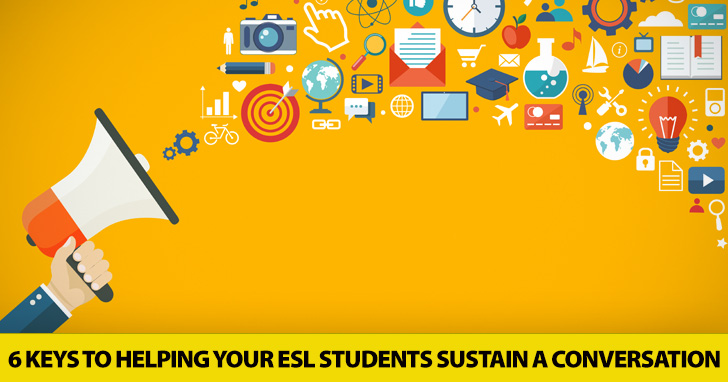Let's Talk: 6 Keys to Helping Your ESL Students Sustain a Conversation


Would you rather “teach” your ESL students or “help them learn”? You might say it’s a “tomayto or tomahto” type of situation – it’s the same thing. ESL students come to class to learn the language skills they need to succeed and socialize in an English-speaking environment, and we’re there to teach them.
When we focus on “teaching”, the teacher takes center stage. Activities that are typically teacher-led involve grammar and pronunciation practice, or any activity that involves controlled practice. Our goal here is to achieve accuracy. But when we shift to communication activities and role plays, and our goal is to work on improving fluency, activities are more student-centered.
So if you want to “facilitate” more and “teach” less, for any task, here are 8 ways you can go about it.Students should be encouraged to take a more active role, to become less dependent on us and more autonomous.

Facilitating actually does not involve teaching less, but rather knowing what to teach and when to do it so that there are certain things your students will be better prepared to tackle on their own. For example, let’s say you want to have them listen to a conversation and answer a series of questions about it. If you don’t introduce key vocabulary before the listening, you’ll end up answering more questions yourself about the things they did not understand. By introducing key vocabulary and phrases first, you are effectively preparing them for the task at hand, one that they should be able to complete on their own, with no help from you.
When it comes to role plays or situations they have to act out, they might not get very far with only knowing what their roles are (Student A, you’re the shop owner; Student B you are buying a dress). Try acting out the role play with a student first, and then have another pair try it out. Or have the class brainstorm a list of words, phrases or expressions that might come in handy, a list they can refer to as they act out their scene.
What do you do when a student draws a blank? What do you do when they don’t know what to say next? Some of us make the mistake of blurting out the whole sentence or question. Try nudging them with the first word or with a visual cue. For example, say two students are making plans for the weekend. If a student forgets to ask what time they’ll be meeting, you can point to your watch or clock without interrupting the conversation.
Try to be as unobtrusive as possible while monitoring their role plays and discussions. You need to be there and listen carefully for mistakes, but your students must feel the freedom and the confidence to let their thoughts flow. This is why it’s better if you don’t interrupt them while they’re speaking. Make a note of their mistakes and save them for your feedback session when they’re done.
Time limits give students a frame, something that they can use to their advantage. If they start a discussion with no given time limit, you might find they suddenly lose their steam and have nothing further to say. They might also go off into a tangent. Time limits help keep them focused on the task at hand. Students need limits, and your role as a facilitator is to provide them.
Students often have questions about what another student said or a word/phrase they used. Address these questions as soon as the activity is finished. Make sure students understand that their own self-corrections or peer corrections are as important and as valid as the corrections coming from you.
After a fluency activity is completed, there comes the time to share the mistakes they made as noted by you during their interaction. Don’t give them a laundry list of errors. It doesn’t make sense to correct every single mistake. Instead, try to group the mistakes into logical subsets, for example, vocabulary mistakes, words they mispronounced, grammar they used wrong, etc… This way, they’ll have something that is easier to work with, rather than a hodgepodge of isolated mistakes to sort through.
We try so hard to correct them on what they did wrong that we sometimes forget that it’s important to tell them what they did right. Naturally, we shouldn’t ignore the obstacles they’re facing – if there are issues they need to address, they must know about them. Which is why I recommend this simple formula. Offer two pieces of praise for each problem or thing they need to work on. For example, you might say to a beginner, “You have learned a lot of new words, and I can tell you make the effort to use them. You also remember the right phrases to use in a conversation. But you need to keep working on your pronunciation.”
Whether you see yourself as a facilitator, teacher or instructor, the important thing is not the name. The important thing is to focus on providing your students with the English communication skills they need to get ahead. If you sometimes take the time to “facilitate” instead of “teach”, you’ll be helping them make great strides towards greater independence and better fluency.
Do you prefer to see yourself as a teacher or a facilitator? Share in the comments below!